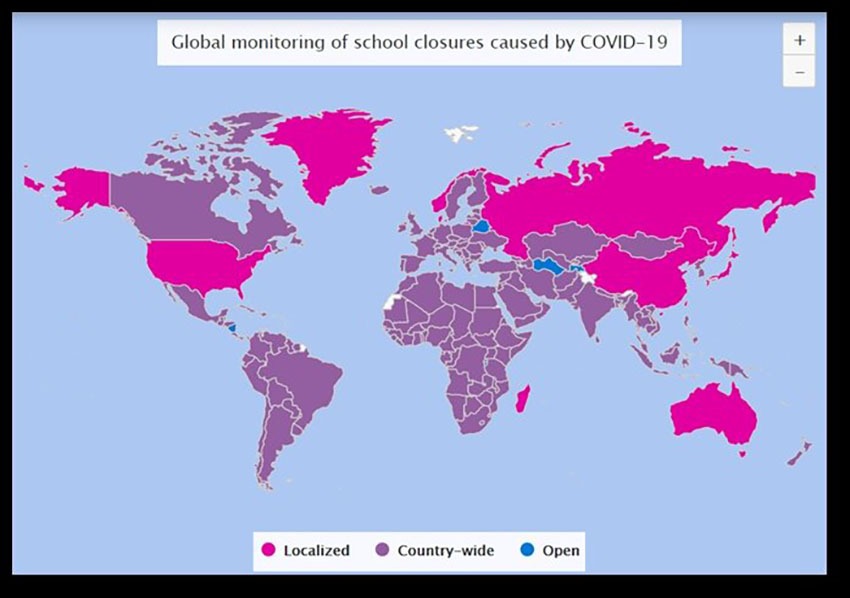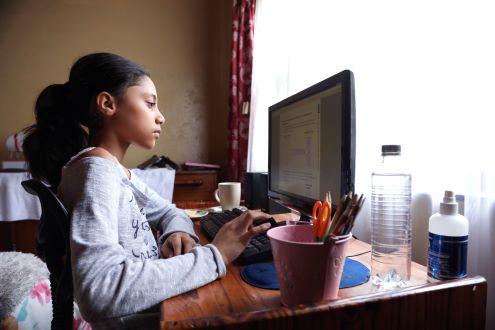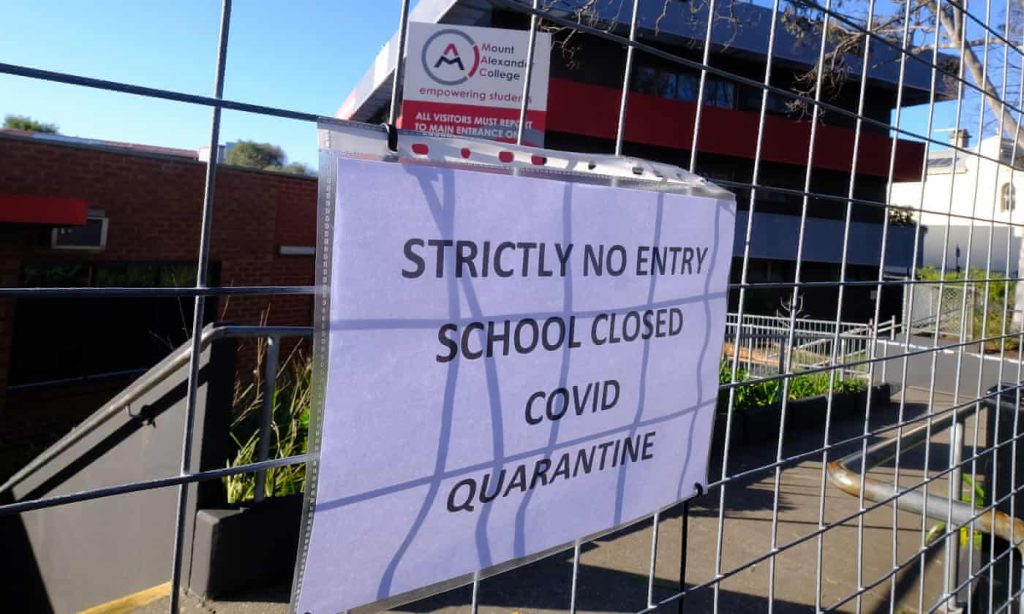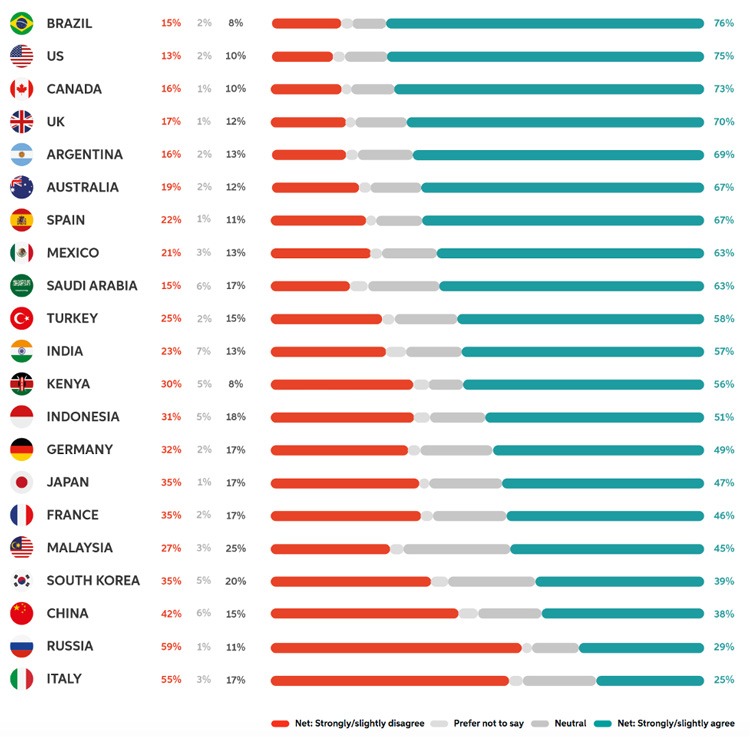Introduction
The COVID-19 pandemic has caused unprecedented disruptions to education. According to UNESCO, by the end of March 2020, over 1.5 billion students had their education impacted by school closures. That means the pandemic has affected 87 per cent of the world’s student population across 165 countries. So, what does this mean for education in a post-COVID world?
As we are turning to the post-covid period, questions about education recovery abound. How has the COVID-19 pandemic affected school? Will students get back to their “normal” schooling? Will students catch up from school closures? How are schools, teachers, students, and parents adjusting to the unstable education situation?

Global impacts and lockdowns.
Source: Mohammad Irfan Research Gate.
What Are The Effects Of COVID On Schooling?
To maintain social distance and stop the virus spreading, most countries around the world had to temporarily close their schools. During the lockdown, teaching in many schools changed to online learning quite suddenly. Since the teachers and students in the world are adjusting to a new virtual learning environment on a large scale, many question the efficacy. There were also some schools which couldn’t provide distance learning. As a result, students fell behind in their academic learning. Some of the causes include inefficient online-learning, lack of computer support for teachers, and limited engagement in online learning.

A student engaged in online learning.
Source: American Psychological Association, The Conversation, Business Insider.
Families admit that home study routines are different from that of a structured school. Thus their behaviours have changed. Teachers soon notice the behavioural challenges after returning to school. They focus on the challenges and bring students back to normal.
Another thing that lockdown brings to students is social challenges. Since students were learning at home, they didn’t have much interaction with their peers. They could not enjoy the friendship and benefit from peer learning, potentially hindering cognitive development.
COVID case rates vary from time and location, but it hasn’t shown any signs of stopping. Even after schools started to operate within the operational frame of COVID-safe, cases still pop-up from time to time in the schools. To keep COVID-safe operations, schools must rearrange and make changes, like limitations of students interaction. Ventilation systems should be introduced to schools for better ventilation.
How About Teachers And Parents In The Pandemic?
Students are not the only “victims”. Teachers and parents grapple with the situation as well. Since the drive for transitioning to online teaching is quick and strong, it puts teachers face challenges as they deal with additional pressure. Some teachers lack sufficient technical skills as most of them are not accustomed to teaching virtually. They must adjust from face-to-face interaction to distant teaching. Teachers need support as well.
Parents seem to work as part of the role of teachers at home during the lockdown. It brings a lot of pressure and anxiety to the families. Especially the families of younger students. The stress of homeschooling adds to their depression. Gradually, they learn coping strategies to deal with the new situation.
How Has COVID-19 Affected Learning Processes In Schools Located In Remote/Poor Areas?
The pandemic may increase education inequalities. The largest challenge amid the pandemic is the digital divide. Without enough technologies to support students, learning becomes difficult. It is reported that teachers could not contact a certain amount of students because of the digital gap. These students lack internet or adequate electric devices to engage with distance learning. They sometimes have to drive to McDonald’s and park in the parking lot and do their work all day there.
Let’s look at some of the data on the digital divide in Africa to grasp the issue. Only 11% of learners in sub-Saharan Africa “only 11% of learners in sub-Saharan Africa have a household computer and only 18% have household internet, as compared to the 50% of learners globally who have computers in the home and the 57% who have access to internet” (Her Excellency Sahle-Work Zewde, n.d.). Wiping out the digital divide could narrow the education gap between urban and remote areas. Internet will provide a more equitable education for students all over the world.
Teachers also require training to deliver distance and online education effectively, but such support is scarce in low-income countries. Across sub-Saharan Africa, just 64% of primary and 50% of secondary teachers have received minimum training, and this frequently does not include information and communications technology (ICT) skills.
Long term effects of pandemic on post-COVID education
What Effects From The Pandemic Are Ongoing?
With vaccinations becoming more prevalent, schools seem to be returning to normal. But is this the case? Many Australian schools have ceased operation temporarily due to COVID cases after students returned to school. Schools have to manage COVID-19 cases at school or local outbreaks with COVID-safe operation during post-covid education.

A school in Flemington, Melbourne, that closed due to a COVID outbreak in August.
Source: Guardian.
However, as new variants keep showing up like Delta and Omicron, nobody knows when the next lockdown will be. Doubt lingers in the thoughts of people. It is definitely an unprecedented uncertain period of time for everyone.
Students normally fall behind in academics after school closures, according to research. Many researchers are not optimistic about the short term impact of the pandemic lockdown. Dramatic long term impacts on students’ competencies are also documented. Considering the length of both school closures and the post-COVID situation, it is too early to indicate the long term impact on the learning. If there is still learning loss could students catch up? Will the lockdowns cause permanent changes regarding students learning aspirations? It might depend on the resilience of everyone and the hard work of teachers, students, and parents in post-COVID education.
What Are The Students, Teachers And Parents Facing During Post-COVID Education?
During post-COVID schooling, students need to transition from online learning to face-to-face lessons. However, students must prepare for any sudden change. For example, a COVID breakout might lead to school non-operation for a couple of days. Distance learning can not make a seamless connection with classroom learning. Students should become resilient when this happens and adjust feelings, routines, learning plans as well.
Apart from academic learning, students’ social development is also important. They need to follow some COVID-safe procedures while engaging with other students. Lockdown and temporary school shutdown isolates students from their peers and teachers. Keeping students connected to their peers is a must for good mental health.
It is also a challenging time for teachers. During the lockdown, the teachers had to become familiar with online education fast. They learnt to do virtual teaching and prepare relevant online resources. During post-COVID, teachers are hardly going back to their normal teaching immediately. They need to pay more attention to students’ well-being. They have to be prepared to jump between virtual teaching and classroom instruction. Some teachers might want to combine the two ways to optimise teaching efficiency. COVID definitely leads to change for teachers and education.
Parents of students have never been harder. Some of them are working at home while assisting students in learning. This dual pressure drives parents crazy. It is always complicated to be a parent and teacher at the same time. During post-covid, parents are supposed to support students more than ever. They need to be ready for any sudden disruptions to work and life. In addition, parents should cope with teachers to help the students go through this difficult time.
Student wellbeing during post-cOVID Education
How Is Student Wellbeing During Post-COVID?
Student wellbeing becomes a focus in the post-COVID period. One survey finds that the majority of students are struggling with mental health during COVID. Online learning can be lonely and isolated. These experiences during lockdown could traumatise students. Students might have mixed feelings about returning to school. They could be nervous and excited. They might feel anxious and uncomfortable when sitting in the classroom, surrounded by many students.

Graph representing students feelings on their mental health during COVID.
Source: ICEF Monitor.
Regarding this issue, governments provide wellbeing services to help students. Many programmes are created to help students develop strong coping mechanisms. Teachers are focusing on student wellbeing and teaching wellbeing courses to help the students. They are key in protecting students’ mental health. The kids are learning to identify their fear, anger, and anxiety to cope with these negative feelings. In addition to that, talking and listening can help with them too. Parents could develop closer relationships with their children if taking this as an opportunity.
Due to the economic shock associated with COVID-19, countries are facing fiscal policy challenges. This is likely to affect educational funding. Many families are experiencing financial hardships. The pandemic has led to an increase in unemployment and underemployment. This in turn is also influencing the students’ wellbeing.
How About Teachers And Parents Wellbeing?
This unprecedented pandemic is throwing a huge challenge to everyone, including teachers and parents. Teachers are under pressure to adjust to teaching. Everyone is expecting more from teachers, especially during home schooling. The parents with school-aged students had a stressful experience of home-schooling, as they had to adjust to working from home, along with having their children at home while they worked.
Technologies Play A Significant Part In Helping To Cope With Post-COVID Education
Although people are physically isolated, the internet helps them connect. People have the option of doing e-learning and interacting through online games. They can make visual calls to their families and friends. These choices allow them to feel connected.
Schools Located In Remote/Poor Areas
There have been significant impacts on health-related and economic dimensions of well-being in rural areas. These impacts are shared within education. Governments reach out to help students in remote areas. An episode of Harvard Edcast provides more information about it.
COVID-19’s Impact on rural schools.
Source: Edcast.
Moving Forward With Post-Covid Education
Lockdowns and school closures impacted students learning, social development, and wellbeing. Governments, schools, and parents are playing each others role to help mitigate the negative influences. But people still need to pay more attention to the long term effects of the pandemics on post-COVID education. The digital divide is curbing students studies in rural areas for remote learning in a pandemic situation. For each individual, try to use this hardship as a once-in-a-lifetime opportunity to be resilient and to reimagine our future education. It is also a call to action, for our desired future education. With everyone all together, we could make the most out of the situation and keep students thriving in the post-COVID education.
achieving the United Nations Sustainable Development Goals (SDGs) and how they link to Post-Covid Education
“The 2030 Agenda for Sustainable Development, adopted by all United Nations Member States in 2015, provides a shared blueprint for peace and prosperity for people and the planet, now and into the future. At its heart are the 17 Sustainable Development Goals (SDGs), which are an urgent call for action by all countries – developed and developing – in a global partnership. They recognize that ending poverty and other deprivations must go hand-in-hand with strategies that improve health and education, reduce inequality, and spur economic growth – all while tackling climate change and working to preserve our oceans and forests.
The SDGs build on decades of work by countries and the UN, including the UN Department of Economic and Social Affairs.”
United Nations
Post-COVID education connects to SDG4, which is “Quality Education“. Children need a quality education so they contribute to the future of their various communities and education. Covid changed the way the world interacts, moving us further and faster into a digital future. Teachers, especially in developing nations, need education themselves so that they can deliver expert online education.
A Thrivable Framework
Welcome to the THRIVE Framework. If the SDGs are the goals, the Framework is the path, the strategy, to which team humanity can score points for the future. The THRIVE Framework, otherwise known as the “Systemic Holistic Model“, is made up of 12 Foundational Focus Factors (FFFs), of which I’ve already introduced you to a couple. Together, along with back-casting, this Framework works together to send humanity hurtling towards thrivabililty. Back-casting is setting up your goal and then working your way backwards to find the steps to achieve your outcomes.
THRIVE also offers businesses and people a tool they can use to calculate how sustainable they are. This is called the THRIVE Platform. If you want more information on how to access and use this, please contact us.
The THRIVE Framework’s original target audience was business entities. However, once you familiarise yourself with the FFFs, you will see that these principles can be used at the microcosmic and individual scale, also.
During the article, we touched on several FFFs. Finite Resources and Systems Thinking are the most obvious. However, we also explored FFFs such as Strong Sustainability, Regenerative Economy, Complex Wicked Problems, Values Based Innovation, and Entity Model. Following is the brief rundown on these FFFs that I promised earlier. I always keep my word. Please feel free to explore the provided links to the pillar pages that discuss these FFFs in detail. A lot of time and work has gone into these by our dedicated volunteers.
Complex Wicked Problems
A complex, wicked problem refers to a social, cultural, political, or economic problem that is difficult to solve. The term wicked refers to the fact that many problems are hard to define, complicated, and defy conventional thinking or simple answers. Many complex wicked problems also become exacerbated by climate change. Often the solutions to one problem causes difficulties in other areas.
COVID-19 drops into the category of complex, wicked problems. It came about because of various issues and it caused more problems than we can count on two hands and two feet. COVID-19 affected schooling on a massive scale. Not only was learning disrupted, other issues appeared, such as stress, depression, isolation, and other mental health problems. Down the track, these issues will cause other problems, as the children of the pandemic become adults.
Entity Model
Entity models aim to navigate what entities can do. An entity can be anything from a small, single-celled organism to the entire cosmos. These models shape the boundaries that outline their limits. THRIVE’s logo, a ciambella chart, outlines two important boundaries for humanity to adhere to so that it can achieve thrivability. One is a social floor, denoting the minimum for an entity’s survival. The other is an environmental ceiling. This environmental ceiling is where the environment can no longer recover from the damage, which can deprive entities of what they need to survive.
Students, parents, and teachers are all entities on the individual level. Schools are also entities on a much larger scale. There is a minimum of education the individuals need to remain above the social floor. This isn’t obvious at the time of education. It becomes obvious later on, as adults, when they can either find work or not due to literacy and numeracy skills.
Multicapital
Multicapital considers that financial capital is not the only thing that adds value. There are other forms of capital such as human, natural, intellectual, social, or constructed. In the case of parents educating at home, the parents previous life experience is multicapital they drew on to deal with the students now at home. For teachers, they gained new multicapital when they learned to adjust to online and distance education, giving them valuable, transferrable life skills.
Systems Thinking
Our actions interconnect with each other and our environment. Systems thinking is a holistic way of viewing these interactions. What impacts one entity or system may affect another entity or system, either for better or worse. Entities must understand and consider their impacts, even the ones they don’t immediately see.
COVID is an excellent example of how what happens in one system affects others, whether its the systems or nations, health, or education. If the world wasn’t so interconnected, with people able to move about from location to location with ease and swiftness, COVID wouldn’t have spread so hard and fast. COVID impacted nations by overburdening health facilities, shutting down schools, closing businesses, and forcing people to work and study from home.
Post-COVID Education With THRIVE
THRIVE stands for The Holistic Regenerative Innovative Value Entity. That is our name and that is our post-COVID educational game. We aim to walk the talk and we invite you to join us. We have nothing to sell, but we’d like to share with you a new way of thinking and being so that our planet and species has the chance to go beyond surviving and actually thrive.
If your interested in joining us, there are a variety of avenues you can take. One way of keeping us with us is via social media platforms, such as LinkedIn, X, Instagram, and Facebook. However, you could subscribe to our YouTube channel, listen to our podcasts, sign up to our newsletter, stay up to date with our blogs, attend our free webinars, or even join us as a volunteer to make an even bigger difference in this world.























